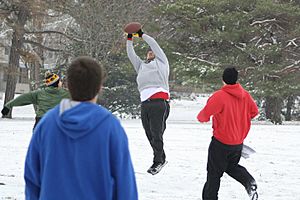Street football (American) facts for kids
Street football, also known as backyard football or sandlot football, is a simpler version of American football. Kids and young people often play it informally. It uses much less equipment and has fewer rules than official football games. Unlike touch football, street football usually involves full tackling.
Contents
How to Play Street Football
Street football games are often played with "house rules." This means the players make up their own rules before the game starts. These rules can change from one neighborhood to another!
Teams and Players
The number of players on each team can be very different. Sometimes it's just "one on one" (two players total), and other times there can be many players on each side. If there are no set teams, players might pick captains who then choose players one by one. If there's an odd number of players, one person might be an "all-time QB." This player plays quarterback for both teams.
Teams usually don't wear uniforms. Players might use the "shirts versus skins" system, where one team wears shirts and the other doesn't. Or, they might wear light-colored shirts versus dark-colored shirts.
Starting the Game
Instead of a regular kickoff, street football often starts with a punt or a throw. Sometimes, teams just start with the ball at a certain spot, like a touchback in professional games.
Downs and First Downs
Just like in regular American football, each team usually gets four chances, called "downs," to move the ball forward. To get a "first down" (which means getting another set of four downs), the team with the ball usually needs to complete two passes or reach a certain spot on the field. Since there are no officials or special equipment, players often use landmarks like trees or driveways to mark where they need to get a first down.
Scoring Points
When a team scores a touchdown, it's usually worth 6, 7, or 1 point. The exact number of points is decided before the game starts. You won't see field goals or extra point kicks in street football because there are no goal posts in backyards or streets!
After a touchdown, the team that scored often stays in the end zone. The other team then gets the ball to start their turn. This is sometimes called "losers walk."
Rushing the Quarterback
One common rule in street football is how the defense can rush the quarterback. There are two main ways:
- Call Rush: A defensive player yells "Blitz!" before the ball is snapped. This lets them rush the quarterback. But if they do this, the quarterback might be allowed to run with the ball more easily.
- Mississippi Rush: The player rushing the quarterback has to count out loud, saying "Mississippi" between each number (like "One Mississippi, Two Mississippi..."). This gives the quarterback a little more time to throw the ball.
Penalties and Fair Play
Penalties are not very common in street football. They are usually only called for serious problems, like someone getting hurt or obvious unfair play. Most games rely on the honor system, meaning players trust each other to play fairly without a referee.
Player Positions
Even in informal games, some players might take on special roles:
- All-Time QB: This player is the quarterback for both teams. This often happens when there's an odd number of players.
- Center: This player snaps the ball to the quarterback. They can also run out for a pass or block for the quarterback.
- Runningback: This player usually runs with the ball. They might also block for the quarterback or catch passes.
Different Ways to Play
Besides the main game, there are other fun ways to play football in streets and backyards.
Crush the Carrier
This game is a free-for-all! One player throws the ball, and whoever catches it tries to run to the end zone. Everyone else tries to tackle the player with the ball and take it from them. There are no teams, and the game can go on and on.
Jump Off
In "Jump Off," two throwers throw the ball anywhere they want. The first player to catch the most passes wins. A similar game is "500". In "500," one person throws the ball to several receivers. The thrower gives points for each catch, and the first player to reach 500 points wins.
7-on-7
"7-on-7" is a team game focused only on passing and defending. There's no tackling, only touching the player with the ball. Teams score points for touchdowns, interceptions, and even for stopping the other team on downs.
Scoring in 7-on-7
- Touchdown: 6 points
- Extra Point (PAT): 1 or 2 points
- Interception: 3 points (and your team gets the ball)
- Turnover on Downs: 2 points (and your team gets the ball)
One on One Football
This game is played with just two people. It usually uses two-hand touch rules. Sometimes, only running with the ball is allowed, and players get four downs, just like in regular football.
History and Video Games
Organized sandlot football has been around for a long time. For example, in 1908, a league started in Rochester, New York. One team from that league, the Rochester Jeffersons, even joined the National Football League (NFL) later on!
Street football is mostly played for fun, without much official organization. However, it has inspired video games. NFL Street by EA Sports is a game where NFL stars play a simpler version of football. The Backyard Football series by Atari is a kid-friendly game that features child versions of NFL stars.
|


